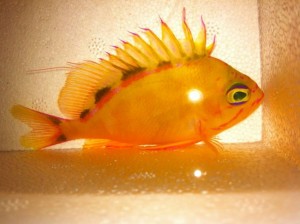 Orange Anthias (Holanthias fuscipinnis)
Orange Anthias (Holanthias fuscipinnis)
At the end of November, we began discussing a piece of legislation targeting the aquarium industry. This bill, called “A Bill for an Act Relating to Aquarium Aquatic Life”, was introduced by the Maui County officials and was created to increase the regulations on aquatic life collecting. We started reading the bill immediately, but it took us a few days to digest its content. But we finally have some details as to what the bill is designed to accomplish.
For starters, the bill proposes that a “white list” of aquatic species for each county be created. The white list will include only those aquatic species that are allowed to be collected. If a fish or invertebrate isn’t on the white list, it cannot be collected for aquarium purposes. Several other rules will also apply to the white list, which are listed below.
Guidelines to become eligible for white list status:
- The species must be able to survive capture, transport, and life in captivity for 180 days
- The fish or invertebrates must be part of a stable and/or increasing population in the collection area
- The collection of the species in a county can’t exceed the average annual collection in that county from 2005-2007
- The removal of the species cannot negatively impact the reef ecosystem by contributing to algae overgrowth, parasite overload, or other reasons
- The species is not endemic to Hawaii (this is the real kicker!!!)
If someone is caught violating these rules, they will face stiff penalties, which are outlined below.
- First time violators may be fined up to $1000, face up to 30 days imprisonment, or both
- Violators who get caught a second time within five years of the first will face a fine up to $2000, 60 days imprisonment, or both
- The third and any subsequent violation within five years come with a fine of $3000 and imprisonment up to 90 days, or both
I hardly know where to start my criticisms of the bill, but I guess I’ll pick the one that is the most glaring to me. If the creators of this bill had their way, fish and invertebrates endemic to Hawaii would no longer be available to the aquarium industry. These would include the bandit angelfish (Apolemichthys arcuatus), Potter’s angelfish (Centropyge potteri), masked angelfish (Genicanthus personatus), orange margin butterflyfish (Prognathodes basabei), orange anthias (Holanthias fuscipinnis), sunrise wrasse (Bodianus sanguineus), and many other fish. Fortunately, yellow tangs are not endemic to Hawaii, as they can be found in other parts of the world as well.
As for the other requirements to be white listed, they are fairly arbitrary, very broad, and most have little to no way of being regulated in my opinion. They will probably just lead to many fish being black listed when they really shouldn’t be. The confusion created by the bill will probably be one of the major limiting factors contributing to fish collecting.





